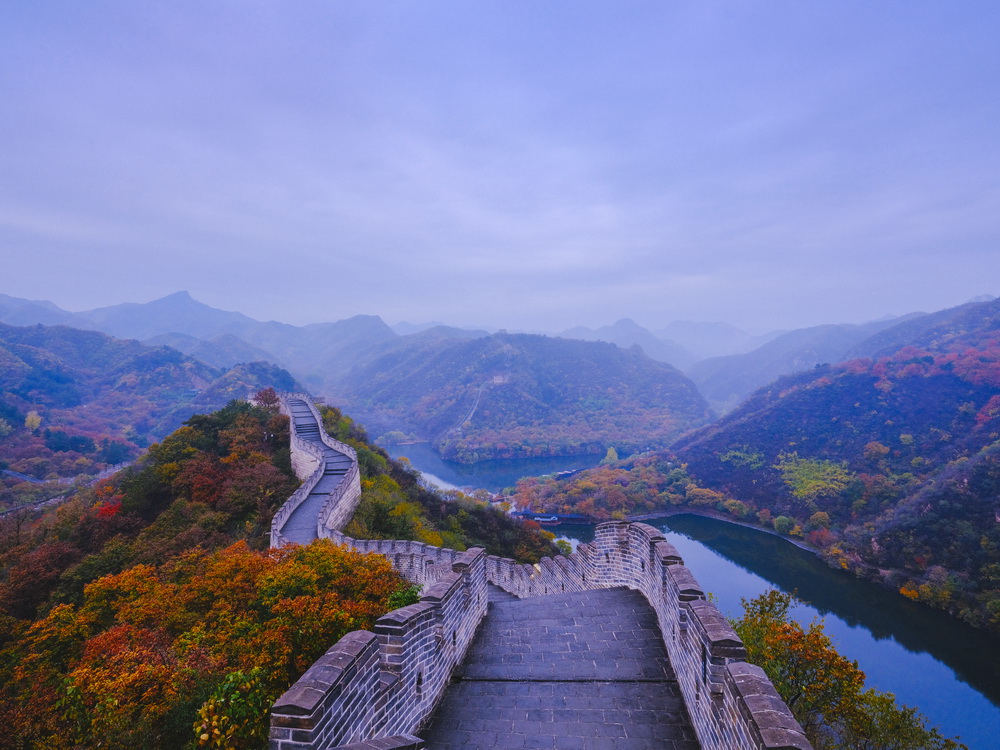
Huanghuacheng Lakeside Great Wall [Photo/huanghuacheng.com]
Huanghuacheng Lakeside Great Wall, a national 4A level scenic spot, is located in Jiuduhe town, Huairou district, Beijing. It is the only segment of the Great Wall that meets a lake, featuring three sections submerged in water. Situated 70 kilometers from downtown Beijing and 35 kilometers from Huairou’s urban area, it is renowned for its stunning landscapes that blend green mountains, a clear lake, ancient trees, and the majestic Great Wall. This site is often described as “the Great Wall where visitors can appreciate both the border scenery and the essence of Jiangnan.”
Rich in resources, the scenic spot offers a beautiful environment with distinct cultural and natural landscapes. Surrounded by lush greenery, it presents diverse and vibrant scenery throughout the year. Visitors can enjoy the picturesque lake and mountains, admire the graceful and majestic Great Wall, and be enveloped by verdant trees and colorful flowers, providing a serene escape from urban life.
The Huanghuacheng Great Wall is named after the abundance of yellow flowers that blanket the mountainside. Built in 1404 during the reign of Ming Emperor Yongle, the Great Wall in water is the highlight of this tourist spot. Initially, it was not built in water, but the construction of the Xishuiyu Reservoir caused the water level to rise, submerging the lower sections of the Great Wall and creating this unique and scenic area.
Haoming Lake
Haoming Lake, originally called Xishuiyu Reservoir, is surrounded by mountains and adjacent to the Great Wall. Formed by natural spring water, the lake's water quality meets the national first-class standard and can be used as a drinking water source. Haoming Lake, with its clear and expansive waters, is an ideal spot for water recreation activities. When boating on Haoming Lake, you can enjoy the sight of mandarin ducks playing in the water. According to the observation of the National Birdwatching Association, the Huanghuacheng Lakeside Great Wall is the largest wild mandarin duck breeding base in Beijing. Every year around the National Day holiday, large flocks of wild mandarin ducks inhabit the shores of Haoming Lake, creating a spectacular and appealing scene for tourists.
The Reservoir Dam
The location of the reservoir was originally known as Xishuiyuguan (West Shuiyu Pass). This pass was the westernmost pass of the Great Wall in Huairou district and the easternmost pass of Juyong Pass in Jizhen Town during the Ming Dynasty. Before the construction of the dam, Xishuiyuguan frequently suffered from floods coming from the upper reaches of the river, and due to prolonged neglect, the pass had become severely damaged over time.
Heilong Tan (Black Dragon Pool)
Heilong Tan (Black Dragon Pool) is located at the westernmost end of the scenic area, surrounded by mountains on all sides. Clear spring water continuously flows into the pool from the surrounding mountains. In summer, when the outside temperature is unbearably hot, Heilong Tan is a haven for people to escape the heat.
According to legend, Heilong Tan was once occupied by a white dragon and originally called Bailong Tan (White Dragon Pool). Initially, the white dragon was generous. During droughts, villagers offered fruits and made supplications, and the dragon would bring rain. However, as time went by, the white dragon's nature changed, and it began to devour children and even raid nearby villages, causing the people great suffering. Upon learning of the white dragon’s deeds, the black dragon decided to fight against it. With the villagers’ assistance, the black dragon defeated the white dragon ultimately, bringing peace and prosperity to the region. In gratitude for the heroic black dragon’s deeds, the pool was renamed Heilong Tan. On the mountainside north of Heilong Tan, a small temple was built to honor the black dragon and pray for favorable weather and good harvests.
From:chinadaily.com.cn





